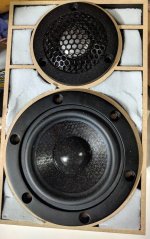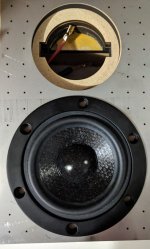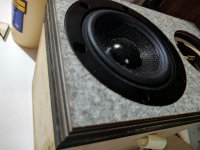I wondered if anyone has experimented with putting a small perforation / slot helmholtz absorber in a baffle tuned to the specific frequency of the main baffle diffraction peak?
Just a random idea.

Just a random idea.
I've not seen that before. I have seen people slot the edges with damping material behind the slots.
Yeah I've seen and tried that too. I found the sharp edge of the recess for holding the damping material caused more issues than not having it.
That could be modeled I think. Gut feeling says a resonator isn't the best way to counter traveling wave issues. Have to look it up, but IIRC the angle of incidence does make a difference with these things.
Need to check the time domain too. Not difficult to test IRL though.That could be modeled I think. Gut feeling says a resonator isn't the best way to counter traveling wave issues. Have to look it up, but IIRC the angle of incidence does make a difference with these things.
Main diffraction peak appears as boost on axis and dip off-axis, if EQd flat on axis it is basically narrowing response. If the absorber worked it would do the same, no boost on axis but sound is cut from off-axis, creating narrowing response. Perhaps would look different on graphs but kind of similar net effect. Big enough slants / roundovers would work though.
EDITED THIS POST!! So sorry if you read it early!
That is not my experience, at least fully. Diffraction causes a boost on axis and a dip off-axis (i.e. focuses energy forwards) at the full wavelength of the baffle width. However to my ears it is more problematic that at half a wavelength of the baffle the on-axis dips and off-axis widens dispersion (i.e. spreads out energy). Since we tend to aim for a flat on-axis response this basically translates to a boosted off-axis response at the half wavelength frequency.
This is why the Seas DXT waveguide works to widen the HF response by adding diffraction at specific locations.

However adding a resonant absorber may simply create another sound source with time 'smearing'. Or maybe it will put a big dip in the response, all theory until one of us tries it!
Below is flat speaker baffle 18cm wide with tweeter centrally located. 1/2 wavelength of 18cm = 3800hz. Note 30deg off-axis response is shown.
Normalised flat on-axis:

Not normalised:

That is not my experience, at least fully. Diffraction causes a boost on axis and a dip off-axis (i.e. focuses energy forwards) at the full wavelength of the baffle width. However to my ears it is more problematic that at half a wavelength of the baffle the on-axis dips and off-axis widens dispersion (i.e. spreads out energy). Since we tend to aim for a flat on-axis response this basically translates to a boosted off-axis response at the half wavelength frequency.
This is why the Seas DXT waveguide works to widen the HF response by adding diffraction at specific locations.
However adding a resonant absorber may simply create another sound source with time 'smearing'. Or maybe it will put a big dip in the response, all theory until one of us tries it!
Below is flat speaker baffle 18cm wide with tweeter centrally located. 1/2 wavelength of 18cm = 3800hz. Note 30deg off-axis response is shown.
Normalised flat on-axis:
Not normalised:
Last edited:
My gut response based on zero thought/study (please weight appropriately!) would be that fiddling with the impedance might be more effective at the edge. If it was my project I would have a quick browse of some of the impedance devices placed on the top noise barriers to get a feel for what might be done and how effective they might be.
Appropriately positioned felt can do a modestly useful amount in some circumstances as I am sure you are aware.
A strong chamfer reducing the baffle around the tweeter to little is likely to be effective but, of course, may not fit the concept of the speaker.
Appropriately positioned felt can do a modestly useful amount in some circumstances as I am sure you are aware.
A strong chamfer reducing the baffle around the tweeter to little is likely to be effective but, of course, may not fit the concept of the speaker.
In the past I have tried adding a quadratic sequence in a ring around a tweeter. It was an awful result! I wonder if the proximity to the osurce requires an insanely fine / high order sequence. I had something like 5deg increments.Why not make the baffle itself a quadratic diffuser?
Yeah there is widening above the narrowing, a dip on axis after the main hump, when wavelength is half of the baffle width. This can be about removed simply minimizing flat area around transducer, minimal/no baffle situation.
I'm not sure if there is magic tricks to get rid of diffraction "completely" other than making the structure approximate sphere, by roundovers /slants. And even these need to be proprtionally sized to the wavelenght. About quarter radius is already quite fine, so on a 10cm flange tweeter add 5cm radius roundover (making total width 20cm). At least on simulators this is the only way to really get rid of diffraction.
One could try to distribute diffraction by distorting the structure, perhaps this is fine for perception, I don't know. It seems more elegant to manage the baffle edge by rounding it though. After first edge/point of diffraction the game is lost because now the secondary edges dont get sound from single point (transducer) but from the previous edge, perhaps a line source with curvature because of delay from the transducer to the first edge. Thinking how this all plays out, how complex it all goes quick, and then figure out ways to mitigate it, one will end up with a sphere.
I'm not sure if there is magic tricks to get rid of diffraction "completely" other than making the structure approximate sphere, by roundovers /slants. And even these need to be proprtionally sized to the wavelenght. About quarter radius is already quite fine, so on a 10cm flange tweeter add 5cm radius roundover (making total width 20cm). At least on simulators this is the only way to really get rid of diffraction.
One could try to distribute diffraction by distorting the structure, perhaps this is fine for perception, I don't know. It seems more elegant to manage the baffle edge by rounding it though. After first edge/point of diffraction the game is lost because now the secondary edges dont get sound from single point (transducer) but from the previous edge, perhaps a line source with curvature because of delay from the transducer to the first edge. Thinking how this all plays out, how complex it all goes quick, and then figure out ways to mitigate it, one will end up with a sphere.
It works like a little eq filter for the decay. With the tiny air gap about -6db can be pulled out with a side effect of a little bit of extra on-axis power. If I made the back chamber larger it would act like the Q on a filter.How are the results? Can you target the diffraction bumps well?
My thread at ASR has a bunch more info. https://www.audiosciencereview.com/...-eton-3-212-seas-l26roy-hypex-pe-boxes.21039/
google "perforated plate nomogram". You need the nomogram to figure out the open area.
Sadly I have been sitting on a bunch of new baffle designs for the metal plate. I want to do one large order with a few different projects and this put it on hold.
The other side of the coin is what motivated me to make the baffle was something that bothered my ears in mono but I could not hear in stereo. For my latest speaker, I am trying to keep the tweeter baffle under 40mm wide. You can skip all of the really bad diffraction this way.
- Home
- Loudspeakers
- Multi-Way
- Baffle Diffraction Helmholtz Absorber?


